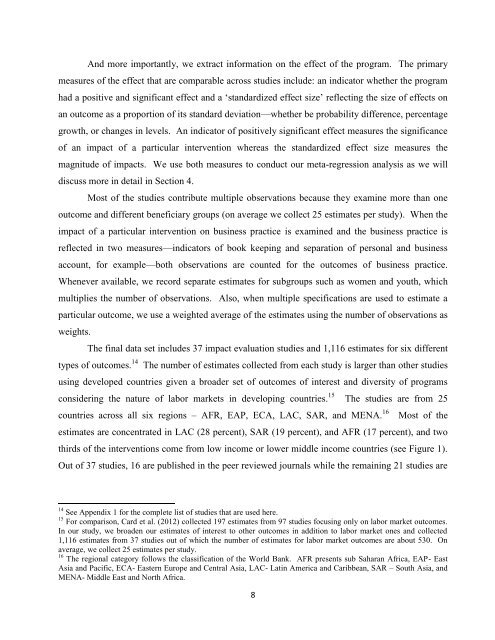Entrepreneurship Programs in Developing Countries: A ... - IYFLive.net
Entrepreneurship Programs in Developing Countries: A ... - IYFLive.net
Entrepreneurship Programs in Developing Countries: A ... - IYFLive.net
You also want an ePaper? Increase the reach of your titles
YUMPU automatically turns print PDFs into web optimized ePapers that Google loves.
And more importantly, we extract <strong>in</strong>formation on the effect of the program. The primarymeasures of the effect that are comparable across studies <strong>in</strong>clude: an <strong>in</strong>dicator whether the programhad a positive and significant effect and a ‘standardized effect size’ reflect<strong>in</strong>g the size of effects onan outcome as a proportion of its standard deviation—whether be probability difference, percentagegrowth, or changes <strong>in</strong> levels. An <strong>in</strong>dicator of positively significant effect measures the significanceof an impact of a particular <strong>in</strong>tervention whereas the standardized effect size measures themagnitude of impacts. We use both measures to conduct our meta-regression analysis as we willdiscuss more <strong>in</strong> detail <strong>in</strong> Section 4.Most of the studies contribute multiple observations because they exam<strong>in</strong>e more than oneoutcome and different beneficiary groups (on average we collect 25 estimates per study). When theimpact of a particular <strong>in</strong>tervention on bus<strong>in</strong>ess practice is exam<strong>in</strong>ed and the bus<strong>in</strong>ess practice isreflected <strong>in</strong> two measures—<strong>in</strong>dicators of book keep<strong>in</strong>g and separation of personal and bus<strong>in</strong>essaccount, for example—both observations are counted for the outcomes of bus<strong>in</strong>ess practice.Whenever available, we record separate estimates for subgroups such as women and youth, whichmultiplies the number of observations. Also, when multiple specifications are used to estimate aparticular outcome, we use a weighted average of the estimates us<strong>in</strong>g the number of observations asweights.The f<strong>in</strong>al data set <strong>in</strong>cludes 37 impact evaluation studies and 1,116 estimates for six differenttypes of outcomes. 14 The number of estimates collected from each study is larger than other studiesus<strong>in</strong>g developed countries given a broader set of outcomes of <strong>in</strong>terest and diversity of programsconsider<strong>in</strong>g the nature of labor markets <strong>in</strong> develop<strong>in</strong>g countries. 15 The studies are from 25countries across all six regions – AFR, EAP, ECA, LAC, SAR, and MENA. 16 Most of theestimates are concentrated <strong>in</strong> LAC (28 percent), SAR (19 percent), and AFR (17 percent), and twothirds of the <strong>in</strong>terventions come from low <strong>in</strong>come or lower middle <strong>in</strong>come countries (see Figure 1).Out of 37 studies, 16 are published <strong>in</strong> the peer reviewed journals while the rema<strong>in</strong><strong>in</strong>g 21 studies are14 See Appendix 1 for the complete list of studies that are used here.15 For comparison, Card et al. (2012) collected 197 estimates from 97 studies focus<strong>in</strong>g only on labor market outcomes.In our study, we broaden our estimates of <strong>in</strong>terest to other outcomes <strong>in</strong> addition to labor market ones and collected1,116 estimates from 37 studies out of which the number of estimates for labor market outcomes are about 530. Onaverage, we collect 25 estimates per study.16 The regional category follows the classification of the World Bank. AFR presents sub Saharan Africa, EAP- EastAsia and Pacific, ECA- Eastern Europe and Central Asia, LAC- Lat<strong>in</strong> America and Caribbean, SAR – South Asia, andMENA- Middle East and North Africa.8
















